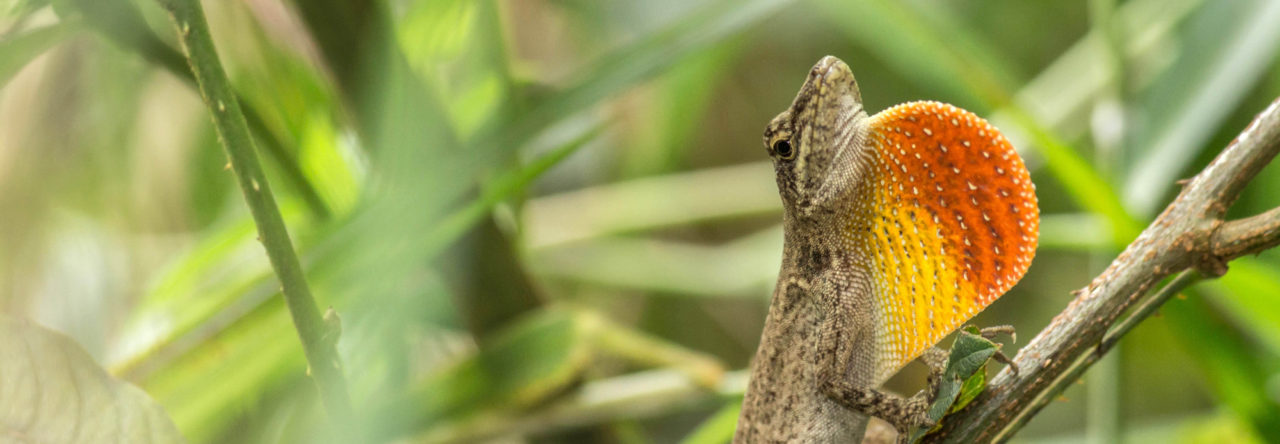
The Puerto Rican grass-bush anole, A. pulchellus, displaying. Recent research indicates that this and some other, but not all, anole species time their displays to occur when the wind isn't blowing. Photo @ Rich Glor.
Successful communication requires that a message be detected by the intended receiver. One trick animals have when they communicate is to use signals that stand out against the background, so that they are more easily detected, such as waving light colored structures against a dark background, or making high-pitched calls when surrounded by low-pitched sounds. But what happens when the background isn’t constant? Just as we tend to talk when conversation partners are quiet, animals would be expected to signal at those times when their signals contrast to the greatest extent with the background and thus are most detectable. Reasonable as this hypothesis is, it has only been tested once, in a study which showed that lab monkeys vocalized in silent periods between bursts of machine generated white noise.
Anoles signal primarily in two ways, by moving their head and body up-and-down and by extending their dewlaps. With regard to the former, research has shown that headbobs are effective at catching the attention of other lizards because the rapid and jerky movements contrast strongly with motion in the background. However, this is only true when, in fact, the background—that is, the vegetation and other stuff behind the lizard—isn’t moving very much. When the wind is blowing and leaves and branches are swaying back and forth, headbobs should be more difficult to detect. Consequently, on a windy day, a savvy anole should time its headbobs to occur when the wind is not blowing.
And that’s just what they do—at least some of them. In a recent study (see the great video story narrated by the author here), Ord et al. confirm that, indeed, the greater the wind speed, the less an anole’s headbobs stand out. And, as predicted, Puerto Rican anoles modulate their behavior, such that the stronger the wind, the more they tend to display between gusts.
But there’s a catch: Jamaican anoles ignore the wind. Why? Don’t they care if no one can see them bob? Turns out they might not, because they’ve got another trick up their sleeve, or at least under their jaw. Jamaican anoles tend to flash their dewlaps rapidly while keeping their bob sequence short, opposite of how the Puerto Ricans behave. And it turns out that a rapidly furling and unfurling dewlap is a great way to draw attention (i.e., readily detectable), regardless of how windy it is. As a result, the Jamaicans may not need to modulate their headbobbing to capture the attention of potential viewers.
So, for whatever reason, the Puerto Rican cristatellus and Jamaican graham clades have evolved different approaches to communicating, and as a result, they respond differently to environmental conditions. Ord et al. point out that this is an example in which convergent evolution in similar environments fails to occur; distantly related species occupying the same environment have not evolved the same solution, perhaps as a result of the different evolutionary paths embarked upon by their ancestors millions of years ago.
- Evolution in Real Time on Lizard Island - March 23, 2025
- Spider Snags Adult Anolis osa - March 22, 2025
- An Homage to the Green Anoles of New Orleans - March 21, 2025


2 Pingbacks